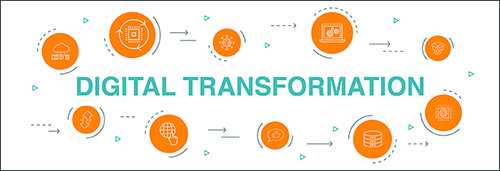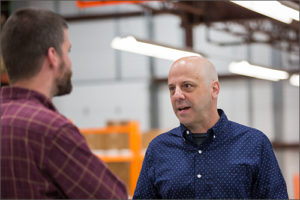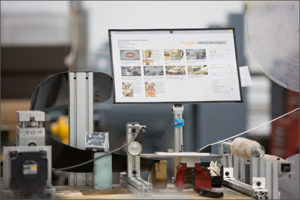 Flexo Concepts has completely transformed the way it does business.
Flexo Concepts has completely transformed the way it does business.
Digitally, that is.
It began the way all of our projects do, with a vision – to create a digital cohesiveness throughout our company to optimize our customers’ experience with us – and a plan to make that vision a reality. Together, they led us down a 4-year path of pervasive digital transformation that reached into every corner of our company and united all of our business functions.
“A company’s digital transformation may not be very noticeable from the outside,” said Greg Howell, Flexo Concepts’ president and de facto project leader. “If done correctly, customers won’t notice initially. But over time they will see increasing examples of improved experiences as they engage with suppliers who are transforming.”
 A successful digital transformation requires hard work that needs to be done inside the organization, necessitating a sustained, company-wide focus on a long-term goal and plenty of patience along the way. A key player in the company’s transition was Flexo Concepts’ Supply and Customer Experience Manager, Phil Ryan. Together, Greg and Phil piloted a process to attack this initiative over a period of 4 years, leading to countless examples of technology being used in game-changing ways.
A successful digital transformation requires hard work that needs to be done inside the organization, necessitating a sustained, company-wide focus on a long-term goal and plenty of patience along the way. A key player in the company’s transition was Flexo Concepts’ Supply and Customer Experience Manager, Phil Ryan. Together, Greg and Phil piloted a process to attack this initiative over a period of 4 years, leading to countless examples of technology being used in game-changing ways.
From the start, Greg realized the importance of drawing ideas and buy-in from all areas of the company – not just IT or Sales where the initiative started, but also Accounting, Engineering, Operations, Marketing, Manufacturing and Customer Experience. This was important not only to generate the best ideas, but also to ensure that knowledge and capability were distributed throughout the company and not centered around a few people. He was sure that everyone in the organization – from top to bottom and across – needed to work together for this to succeed. And so, our “Digital Transformation Team,” with representatives from each department, was born.
Since the beginning, the team would gather every other week to communicate progress, celebrate “wins”, vet ideas, and plan next steps. Tasks were decided upon, and members would return to their departments after each meeting with tactical to-do lists. Gradually, the assignments were moved from “to-do” status to “completed” and crossed off the list.
 Over time, wonderful things began to happen in different parts of the organization. Tighter control over billing and collections, better cost tracking, easier multiple currency billing and simplified sales tax management were achieved in the accounting department, for example. Our engineers started using “cases,” or CRM system tickets, to manage the process of blade analysis. Manufacturing personnel came to enjoy the ease of using an on-platform shipping tool that allowed direct creation of shipments from a sales order within a single application. SOP’s and master batch records created clear, accessible guidelines for daily operation in a digital format. New inventory management automation and a centralized procurement system ensured access to accurate, up-to-the-minute levels of available product, improved cost allocation and better raw material tracking. The customer experience team began using surveys to gauge the company’s performance at not only meeting customers’ current needs, but also to get a sense of new services people would like to see from us.
Over time, wonderful things began to happen in different parts of the organization. Tighter control over billing and collections, better cost tracking, easier multiple currency billing and simplified sales tax management were achieved in the accounting department, for example. Our engineers started using “cases,” or CRM system tickets, to manage the process of blade analysis. Manufacturing personnel came to enjoy the ease of using an on-platform shipping tool that allowed direct creation of shipments from a sales order within a single application. SOP’s and master batch records created clear, accessible guidelines for daily operation in a digital format. New inventory management automation and a centralized procurement system ensured access to accurate, up-to-the-minute levels of available product, improved cost allocation and better raw material tracking. The customer experience team began using surveys to gauge the company’s performance at not only meeting customers’ current needs, but also to get a sense of new services people would like to see from us.
Internal and external quality issue tracking through digital cases enable us to recognize issues early, investigate them, and resolve problems as quickly as possible. Internal costs savings were realized, too, when the operations department declared “paperless status” in September 2019, eliminating over 87,000 pieces of paper and about $10,000 in related expenses annually! An order is now received, processed, manufactured, packed, shipped and invoiced using only a single piece of paper – the packing slip.
 The sales and marketing teams were also rewarded with automated processes to pinpoint customers’ pain points and offer customized solutions. The integration and optimization of software systems provide quick and easy account “snapshot” analysis and tracking via personalized dashboards, providing our salespeople with all the information they need at their (keyboard-operating) fingertips. Our marketing staff has gained tools to determine the information prospective customers are looking for and deliver it to them not only when they want it, but how. A central repository offers the entire international team access to all online marketing collateral, and a Kanban process enables them to request sales support materials digitally.
The sales and marketing teams were also rewarded with automated processes to pinpoint customers’ pain points and offer customized solutions. The integration and optimization of software systems provide quick and easy account “snapshot” analysis and tracking via personalized dashboards, providing our salespeople with all the information they need at their (keyboard-operating) fingertips. Our marketing staff has gained tools to determine the information prospective customers are looking for and deliver it to them not only when they want it, but how. A central repository offers the entire international team access to all online marketing collateral, and a Kanban process enables them to request sales support materials digitally.
Today, we are proud to report that 100% of our business processes are in the cloud (except for a few processor-intensive applications and some local file storage). Our entire office staff company-wide has access to all job functionality via the web, facilitating remote operation on laptops, iPads, mobile phones and other devices. As a result, we now have maximum flexibility to maintain uninterrupted service to our customers despite unforeseen events that may impact our ability to operate from a central location.
Greg sees our company’s digital transformation as a logical extension of our continuous improvement mindset and believes that you can’t really do one without the other. “Our culture has always placed an emphasis on finding ways to work smarter and leverage technology to do it. Much like continuous improvement, meaningful digital transformation is an accumulation of very small improvements done over time that come together to create large, efficient and more capable systems.”
It began with the belief that if we could create a digital record of all our customer interactions, we could attain operational bliss and deliver amazing experiences for our customers. And we did. For now. Because, almost by definition, digital transformation is a never-ending process with infinite room for improvement. As our ways of conducting business keep evolving, our technology capabilities grow, and our customer focus remains steadfast, there’s no doubt we will continue to “transform.”
